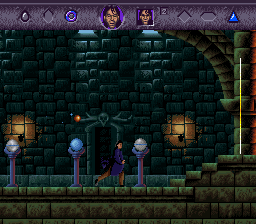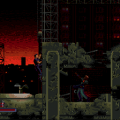In 1989, Warlock, a fantasy horror film directed by Steve Minerand starring Julian Sands as the titular warlock, saw the light of day. The film focusses on said warlock being sent to the future by Satan to assemble a book that will undo the creation of the universe. Whether that will also destroy both the warlock and Satan is never explored. The film, frequently compared to The Terminator by critics, was a modest success. Despite failing to recoup its budget at the box office, Warlock spawned a sequel named Warlock: The Armageddon, also known as Warlock II. There was also a comic series, an unfortunate copycat murder, yet another sequel called Warlock III: The End of Innocence – this one going straight to video – and a video game adaptation for Super Nintendo Entertainment System and Genesis .
The adaptation is simply called Warlock, though it is primarily based on the 1994 sequel. It was developed by Realtime Associates and published by Trimark Interactive, partnering with Aklaim Entertainment for the Genesis version, and LJN for the Super Nintendo version. The film sequel again stars Sands as the titular warlock and son of Satan, though the plot is entirely different. This time, the warlock attempts to gather six ancient gemstones to summon his father while a young couple, both from a line of druids and druid warriors who have opposed Satan for centuries, try to stop him. The game copies this basic idea, but features a different modern-day druid and no female backup. The warlock is definitely based on Sands, however, whose face from the film poster is even used for the game over screen. His father, however, is now the Evil One to keep things free from satanic corruption.
Warlock is, for the most part, a fairly conventional 16-bit platformer. In Warlock: The Armageddon, the druids primarily use telekinesis and control over nature and the elements to fight, whereas the protagonist of the game is equipped with a magic blast instead. Alternatively, he can use a magical orb which, while slow, is useful for reaching certain enemies, as it can be sent into eight different directions. The lucky little orb can even snatch items! This is an interesting detail possibly lifted from the film, where protagonist Kenny telekinetically moves a baseball and uses it as a weapon. The druid warrior also has access to a number of spells disposable items, among them healing potions, magic shields, and various attack spells.
As fast as the druid launches magic projectiles and as swift as he is on his feet, Warlock is not a fast-paced game. The protagonist’s high movement speed is more of a beginner’s trap, and most of the time, a slow and methodical approach is the way to go. Enemies can take a lot of hits, and many are better disposed of with the magical orb. Additionally, the druid moves very fluently, and while he is not quite royalty from Persia, every jump is better executed with precision – something that Warlock unfortunately lacks. While inputs are not technically delayed, there is no way to skip animations, and an impatient player may find themselves trying to execute so many commands in a short amount of time that the ones at the end of the queue simply get eaten.
The controls do not help either. As many a Genesis game, Warlock was designed for a three-button controller, resulting in the player having to use a combination of the d-pad and the pause button to cycle through and use items. This rather awkward control scheme was left unaltered (or originated from) in the Super Nintendo version, extra buttons be damned. Even beyond the controls, Warlock is not a forgiving platformer. Enemies are fast, hazards are everywhere and not always easily identifiable as such, falling damage is seemingly dished out for any fall greater than the druid’s height, and while the many foreground elements in Warlock look neat, they frequently obscure the already small enemies. Warlock’s saving grace are its passwords – presented as time travelling spells – for which there are multiple for each stage. Without them and a playtime of about 90 minutes, the game would be almost unplayable.
The atmosphere is where Warlock truly shines. The soundtrack is appropriately grim and moody, and works well on both systems. Even the interface is creepy and instead of a traditional health bar, it displays he druid’s head and carves off more and more flesh with every hit until nothing but a skull remains – no doubt inspired by Wolfenstein 3D and first-person shooters. The visuals are quite appealing, and unique assets are found throughout a lot of levels. The game also manages to give the player the feeling of truly being on the hunt for the runestones by having the eponymous warlock pop up from time to time, usually without facing the druid directly.
Warlock starts in New England, where, the warlock turns a couple of dogs the player just passed into monsters, and burns down a bridge to delay the druid. Later on, he raises the visitors of a library as zombies. The destruction of the bridge is accompanied by clouds darkening the previously sunny sky, one of many nice touches Warlock has to offer. After a short duel with the warlock, the druid recovers the first runestone and jumps through a portal. Here, the druid fights his way through the garden and castle of a wizard to recover three more stones. The warlock uses this opportunity to animate a couple of gargoyles and archer statues to throw at the player. The wizard’s castle turns out to be extensive enough to give Dracula a run for his money, with hallways, dungeons, a laboratory, and central heating.
Interestingly enough, while the wizard harasses the druid all the time, the two never face off directly. Instead, the warlock and the wizard, both transformed into monsters, face off, the wizard gets killed, and the druid has to fight the warlock over the wizard’s last runestone. The fifth runestone is hidden in the world’s most extensive mausoleum, and Warlock does get a little bit repetitive here. The previous caves and castle halls overstayed their welcome a bit, and despite nice water visuals, the mausoleum and the adjacent graveyard do not feel fresh enough in more than one way. The following mountains and caves a little bit better, but again go on a little longer than they should. The finale, however, during which the warlock turns into a devil, is quite satisfying.
The Super Nintendo and Genesis versions of Warlock are fairly similar, but have a couple of differences. The expected technical differences such as different resolutions, color palettes, sound, and music are all there. Additionally, the stages layouts differ as well, as do some of the stage gimmicks. The library, for example, features an elevator in the Genesis version, but only staircases on the Super Nintendo, which also features atmospheric rain in the garden level and fog over the graveyard. More noticeable is the penultimate segment of the wizard’s castle: – on the Genesis , the room has a background and slowly fills with what appears to be boiling blood, whereas the Super Nintendo variant features an all-black background and raising flames instead. Another significant different is the way the druid’s magical sphere moves; it moves faster in the Genesis version, but does not do so in a wave pattern, covering less ground. However, all differences combined do not significantly later the experience, and only die-hard Warlock fans will get something out of paying both version. Which version is superior? That is debatable, though critics at the time – who were overall mixed on Warlock – favored the Super Nintendo version.
Overall, Warlock is most certainly better than the budget film it is based on – which has little to offer beyond Julian Sands chewing the scenery –and a good example of the developers largely abandoning the source material for the better. Released in 1995, near the end of the 16-bit era, Warlock failed to enchant the masses, but remains a solid if somewhat flawed platformer
Screenshot Comparsions
[/one_half] [/one_half]

